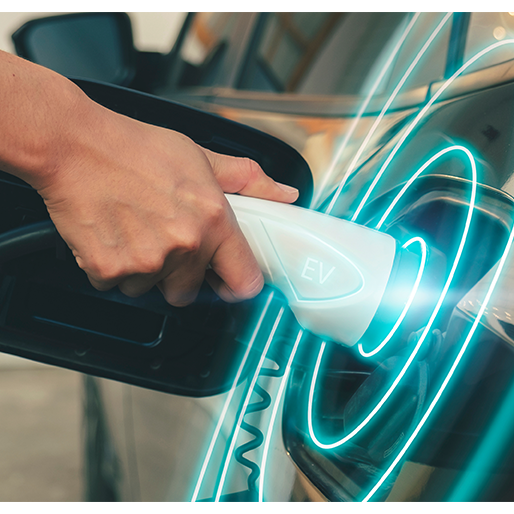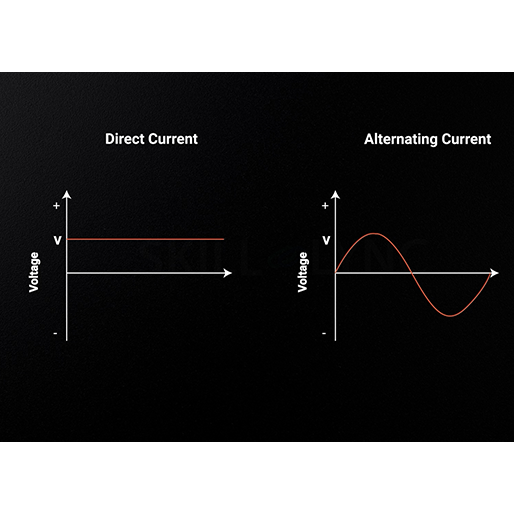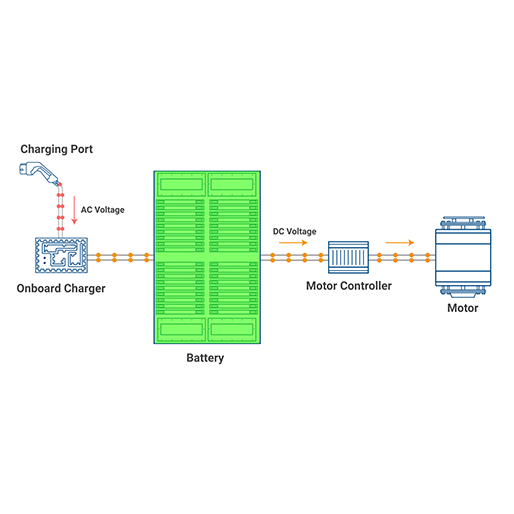Modified on
How do EV Charging Works and its Benefits

Skill-Lync
Imagine this: You're traveling on a long road trip in an EV. suddenly your car runs out of charge and stops in the middle of nowhere, what would you do? If only there was an EV charging station nearby for you to charge up and be on your way this causes range anxiety. EV charging infrastructure is the biggest obstacle hindering the widespread adoption of EVs. In this blog we’ll explore the growing need for EV charging infrastructure, the benefits of having it, and the challenges of creating it.

Electric Vehicle (EV)
A vehicle that uses one or more electric motors for propulsion is referred to as an electric vehicle or an EV. Electric vehicles are environmentally friendly because they do not emit any greenhouse gases, have fewer moving components that need to be maintained, and have minimal operating expenses. EVs employ lithium-ion batteries which are the industry standard owing to a self-discharge rate of only 5% per month.
Want to know more about Electric vehicles? Check out our blogs.
Charging an EV
An EV charger can be used to quickly charge your EV, plugging it into your house also works, however, it will charge at a much slower phase. Over 80% of electric vehicle owners charge their vehicles overnight at home or at work. Electric vehicles come with a portable charger which can be carried in the vehicle.
There are two types of EV chargers, AC and DC. Usually, the AC current flows out of the socket in our homes, however the batteries can store only DC current.

For example: When charging a mobile phone, the charger converts the AC power into DC power to be stored in the phone's battery pack.
The 3-phase AC is supplied to the car from the grid which has to be converted to DC. The electricity coming from the charger is AC. However, the batteries only store DC. The primary role of an onboard charger is to convert the alternate current from the grid to the direct current. When the charger is plugged in, the AC is first converted into DC and stored in the battery packs.

There are 3 levels of charging namely:
- Level 1 - 2.3 kW
- Level 2 - 22 kW
- Level 3 - 240 kW
EV Charging Infrastructure
EV charging infrastructure is essential for the widespread adoption of EVs, providing a safe and reliable power source for drivers. As more people switch to electric vehicles, the need for EV charging infrastructure will only grow.
The demand for EV charging infrastructure is driven by the growing number of electric vehicles on the road. This is especially true in urban areas, where there is a higher concentration of EVs and limited access to charging stations. In India, there are 1409 electric vehicle charging stations distributed across 169 cities.
Need for EV Charging Infrastructures
Electric Vehicles on a fully charged battery have roughly the same or a slightly higher range than their fossil fueled counterparts. The difference is that it takes EVs much longer to charge than to fill a tank of fuel. This is a huge problem when it comes to long road trips where minutes can change to hours.
- The range of electric vehicles is increasing. As EVs become more capable of traveling longer distances, the need for charging infrastructure increases.
- The need for electric vehicle charging infrastructure is driven by the need for convenience.
- EV owners want to be able to charge their vehicles quickly and easily.
- This means that they need access to charging stations that are conveniently located and offer fast charging speeds.
- The growing need for electric vehicle charging infrastructure is a challenge that must be addressed.
How EV Charging Infrastructure Works
Different charging stations have different outputs. A charging station will charge more quickly if its kW output is greater. An EV charger can be used to quickly and plug an electric vehicle (EV) into your home to start charging it.
Just like any other appliance or item you charge by putting into the wall, an EV charger draws an electrical current from either a 240v outlet or the grid it is hardwired to and distributes that electricity to the car.
- The architecture of a DC charging station can also have a significant effect on power output.
- Standalone stations are made up of a single device and have a minimal power output range.
- Split design consists of two parts:
- A user unit that interacts directly with customers
- A power unit that operates in the background
- Split architecture stations typically produce more power, because a complete unit is devoted to converting and supplying it.
Understanding the Benefits of EV Charging Infrastructure
As the demand for EVs grows, so does the need for EV charging infrastructure. EV charging infrastructure provides the necessary power to charge EVs and is critical for the continued growth of the EV industry. Understanding the benefits of EV charging infrastructure is essential for businesses and governments that are looking to invest in this technology.
EV charging infrastructure provides a number of benefits, including:
-
Convenience
EV charging infrastructure makes it easy for EV owners to charge their vehicles. With the right infrastructure in place, EV owners can charge their vehicles quickly and conveniently, without having to worry about running out of power.
-
Promote Sustainability
EV charging stations can be the simplest strategy to push your business. helps reduce emissions and improve air quality. You can show your clients and employers that you are doing your bit to promote sustainability and reduced emissions by installing charging stations.
-
Improved Infrastructure
EV charging infrastructure can help improve the overall infrastructure of a city or region. By investing in EV charging infrastructure, cities and regions can create a more efficient transportation system and reduce traffic congestion.
The Challenges of EV Charging Infrastructure
There are several challenges that need to be addressed in order to ensure that the infrastructure is efficient and effective.
- One of the biggest challenges is the lack of a unified charging standard. Different EV models use different charging connectors, which can make it difficult for EV owners to find compatible charging stations.
- This issue can be addressed by creating a universal charging standard, which would allow all EV models to use the same charging connectors.
- Another challenge is the cost of EV charging infrastructure. Installing a charging station can be expensive, and the cost of maintaining and operating the station can be even higher.
- The cost of electricity can vary significantly from region to region, making it difficult to accurately predict the cost of charging an EV.
- There is the issue of access. Many areas do not have access to public EV charging stations, making it difficult for EV owners to charge their vehicles while away from home.
The Urgent Need for EV Charging Infrastructure
The lack of charging infrastructure is one of the major barriers to the widespread adoption of EVs. Without the necessary infrastructure in place, drivers are unable to take full advantage of the benefits of electric vehicles. The urgency of the need for EV charging infrastructure is becoming increasingly apparent. This infrastructure is essential for providing drivers with the necessary access to charging stations and ensuring that they can make the most of their electric vehicles. The time to invest in EV charging infrastructure is now, before the demand becomes too great to meet.
To deep dive into topics of electric vehicles, do check out the courses such as Post Graduate Program in Electric Vehicle Design & Development by Skill-Lync. Also check out the other courses to upskill your career along with Skill-Lync.
Author
Navin Baskar
Author

Skill-Lync
Subscribe to Our Free Newsletter

Continue Reading
Related Blogs
The average vehicle body gives any vehicle its structural integrity, while the electric motor is concerned with the generation of torque or force. The electric motor can be a permanent magnet synchronous motor, brushless dc motor etc.
24 Aug 2022
In industrial control applications, a PID controller is a device that regulates temperature, flow, pressure, speed, and other process variables. PID (proportional integral derivative) controllers, which use a control loop feedback mechanism to control process variables, are the most accurate and trustworthy controllers.
26 Aug 2022
A lithium-ion (Li-ion) battery is a complicated battery technology that uses lithium ions as a key component of its electrochemistry. During a discharge cycle, lithium atoms within the anode are ionized and separated from their electrons.
28 Aug 2022
Dash in your car is your source of information. It basically functions as a control panel that sits in front of the driver and shows numerous controls and instrumentation required for your car to function.
31 Aug 2022
A hybrid vehicle has two power sources for motion within the same vehicle. Basically the hybrid vehicle is split into two types supported the source for propulsion - combustion engine type and Hydrogen power cell.
06 Sep 2022
Author

Skill-Lync
Subscribe to Our Free Newsletter

Continue Reading
Related Blogs
The average vehicle body gives any vehicle its structural integrity, while the electric motor is concerned with the generation of torque or force. The electric motor can be a permanent magnet synchronous motor, brushless dc motor etc.
24 Aug 2022
In industrial control applications, a PID controller is a device that regulates temperature, flow, pressure, speed, and other process variables. PID (proportional integral derivative) controllers, which use a control loop feedback mechanism to control process variables, are the most accurate and trustworthy controllers.
26 Aug 2022
A lithium-ion (Li-ion) battery is a complicated battery technology that uses lithium ions as a key component of its electrochemistry. During a discharge cycle, lithium atoms within the anode are ionized and separated from their electrons.
28 Aug 2022
Dash in your car is your source of information. It basically functions as a control panel that sits in front of the driver and shows numerous controls and instrumentation required for your car to function.
31 Aug 2022
A hybrid vehicle has two power sources for motion within the same vehicle. Basically the hybrid vehicle is split into two types supported the source for propulsion - combustion engine type and Hydrogen power cell.
06 Sep 2022
Related Courses
